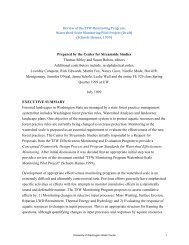c Copyright 2011 Katherine Nichole Deibel Understanding and ...
c Copyright 2011 Katherine Nichole Deibel Understanding and ...
c Copyright 2011 Katherine Nichole Deibel Understanding and ...
You also want an ePaper? Increase the reach of your titles
YUMPU automatically turns print PDFs into web optimized ePapers that Google loves.
4 Chapter 1<br />
different disabilities, ranging from mobility impairments to sensory disabilities to cognitive disabilities.<br />
Although the findings highlight general themes about AT adoption, the diversity of both the assistive tools <strong>and</strong><br />
the user populations are obscured. An additional limitation noted by Dawe is that ab<strong>and</strong>onment is a process.<br />
These prior AT adoption studies have tended to focus only on whether a technology is adopted or rejected.<br />
Emphasizing end states neglects the actual underlying process involved in technology adoption (Rogers, 2003)<br />
<strong>and</strong> thereby limits the identification of potential interventions to prevent rejection.<br />
As an example of an intervention of limited applicability, some studies have found that ab<strong>and</strong>onment is<br />
more likely to occur when an AT is incompatible or fits poorly with an activity important to the user (Riemer-<br />
Reiss & Wacker, 2000). An obvious recommendation is to pay greater attention to the activities engaged in<br />
by disabled users, but this glosses over many complex details. First, each kind of disability affects participatin<br />
in various activities differently. A person who uses a wheelchair will experience different issues playing in a<br />
soccer game than a person with a learning disability. Similarly, writing an e-mail message will involve different<br />
issues <strong>and</strong> challenges for both individuals. Generalization within a single disability type is also problematic<br />
as people with the same disability type may have different degrees of limitations <strong>and</strong> may also not engage in<br />
the same activities with the same frequency. Furthermore, a user is likely to use the same AT across multiple<br />
activities. Issues of compatibility will likely differ across the activities.<br />
Even when the activity <strong>and</strong> assistive technology are compatible, additional factors influence its usage.<br />
Consider the following scenario: a student who is blind <strong>and</strong> a student with a reading disability both access<br />
their textbooks through text-to-speech (TTS) software. TTS software takes an electronic copy of a text <strong>and</strong><br />
reads it aloud. While attending a lecture, the need arises for both students to refer to their textbook. Both have<br />
their laptops present, so they can use the TTS software. To do so, they must either play the text out loud or<br />
wear headphones / earpieces. The former has the potential to be disruptive to other classmates <strong>and</strong> attract their<br />
attention. The latter will make the students st<strong>and</strong> out as wearing headphones is not typical during a lecture <strong>and</strong><br />
may be viewed as discourteous to the instructor. Would the two students use their TTS software during the<br />
lecture?<br />
The blind student will most likely use TTS to access the textbook. Although either usage option has<br />
potentially negative consequences, it is easy to rationalize <strong>and</strong> accept that the blind student needs to do so<br />
because otherwise the textbook is inaccessible. Due to social interactions within the class, the instructor <strong>and</strong><br />
other students will likely have learned of the student’s blindness <strong>and</strong> that he needs to use the technology to<br />
participate in class. Even if the student has not explicitly indicated his disability to others, he will likely have<br />
shown several visible indicators of his blindness. 4<br />
For the reading-disabled, however, whether the TTS will be used is not as clear. Unlike blindness, a reading<br />
disability is not visually recognizable, <strong>and</strong> thus the instructor <strong>and</strong> classmates will only know of the disability if
















